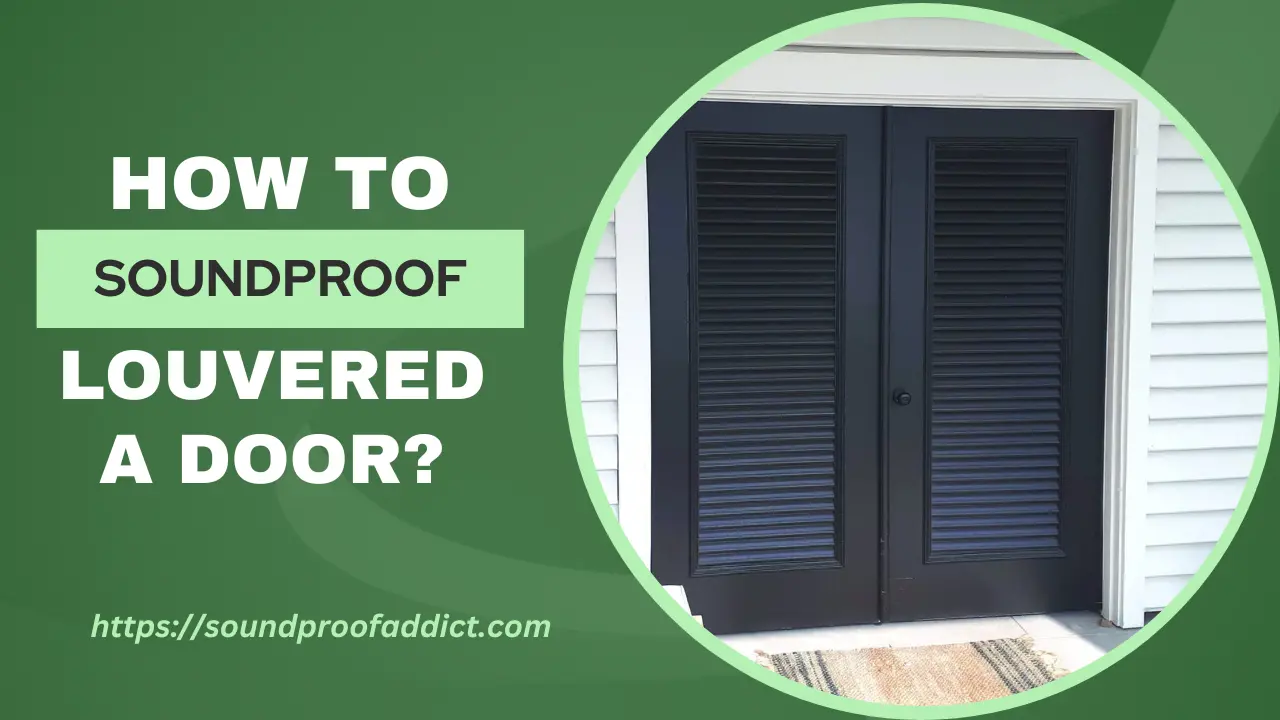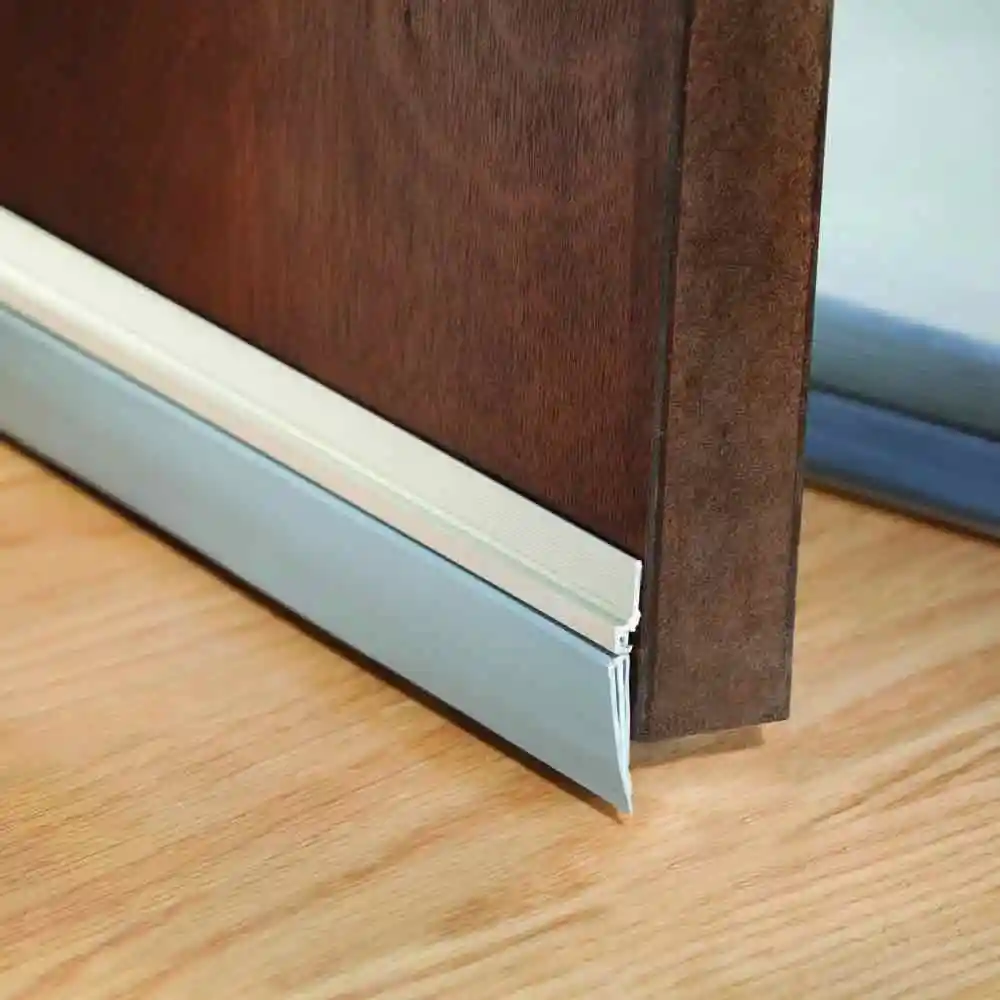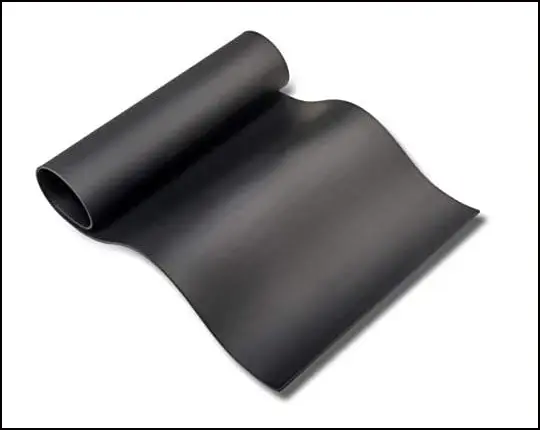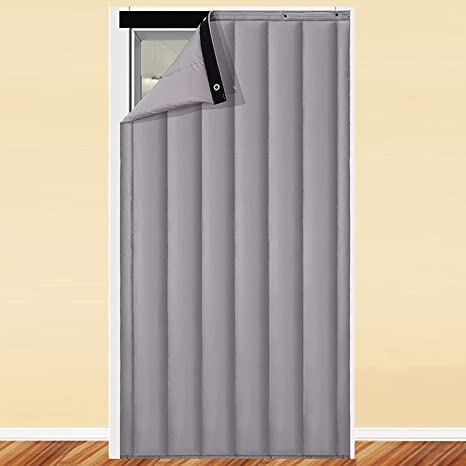How to Soundproof a Louvered Door? {5 Proven Ways}

Do you want to soundproof your louvered door? Louvered doors look so beautiful there is no doubt about it, but their design allows a ton of sound to sneak in which is enough to ruin your peace.
This is a really big issue for homeowners who have louvered doors in their houses. To put it into perspective, there are several ways to reduce the noise coming through louvered doors, but “most of them” make little to no difference.
Fortunately, there are a few methods you can use to soundproof your louvered door. In this article, I’m going to give you five proven ways to soundproof a louvered door, even if you’re on a tight budget.
So buckle up, and let’s dive in!
Do louvered doors block sound?
Louvered doors can block some level of sound. Louvered doors have horizontal slats, these slats have gaps between them. Because of these gaps, sound can go through the door easily.
This happens because there isn’t much surface for the sound to bounce off or be absorbed up by. So, even though louvered doors can stop some sound, they’re not as effective at keeping sound out as doors without those gaps.
So if you’re looking to use louvered doors in a space where you want some sound to travel through, like between rooms, then they could actually be helpful.
Because they don’t block sound as well, they can help maintain a sense of openness and connection between spaces while still providing some level of separation.
But if your main goal is to block sound, you might want to explore other door options such as a solid core door that could be a better fit for that purpose
5 Proven Ways to soundproof a Louvered door
Now, let’s dive into the different techniques for soundproofing a louvered door.
1: Use door sweep underneath the door

A door sweep is a flexible strip usually made of rubber or foam. Its main job is to create a barrier for the sound to enter through the gap between the door and the floor when the door is closed.
You might think the gap under the door is small, but sound can travel through even tiny openings because it travels through the air.
By using a door sweep, you’re blocking this easy route for sound. It’s like putting a “stop” sign in front of noise. It makes it much harder for it to come in. Whether you are soundproofing hollow door, double door (French door) or soundproofing a foldable door, you need to do it.
However, let me clear that installing a door sweep will obviously not block 100% of the sound coming through your louvered door. It’s part of a larger strategy to soundproof your space.
So, it’s not a standalone solution, but it definitely contributes to the overall goal of reducing unwanted noise. A good quality door can you cost you anywhere between $10 to $30, so they are not expensive at all.
Related: Cost of a soundproofing door
2: Use foam board insulation on the back of the slatted door
Using foam board insulation on the back of your louvered door is a cheap way to cut down on sound coming into your living space.
Foam board insulation is a kind of thick foam that helps to trap sound waves and keep them from bouncing around to a certain extent.
So using foam board insulation alone won’t be that much effective. That’s why I would recommend you to use it with materials like plywood or MDF (medium-density fiberboard) to reduce noise more effectively.
Here’s a step-by-step guide on how to go about it:
Materials You’ll Need:
- Foam board insulation
- Plywood or MDF
- Cutting tool (saw or utility knife)
- Construction adhesive
- Measuring tape
- Screws
- Screwdriver or drill
Step-by-Step Instructions:
- Once you have these tools, using the measuring tape, measure the dimensions of your louvered door.
- Using the measurements you’ve taken, cut both the foam board insulation and the plywood to match the door’s measurements.
- Apply construction adhesive to the plywood surface and spread it evenly and then stick the foam board insulation to it. Make sure to use construction adhesive to stick the foam board insulation to the plywood.
- Allow the combination of foam board insulation and plywood to set for around 24 hours to ensure a strong bond.
- Alright, now take the combo and using screws, attach it to the back of the door. Drive screws through the plywood and foam board insulation and into the door.
- To blend the newly added layer with your room’s aesthetics, you can choose to paint or decorate the drywall surface.
Combining foam board insulation with plywood creates a dual-layer barrier against sound transmission. The foam board absorbs sound waves, while the plywood adds an extra layer of density and sturdiness.
Other than that, this soundproofing techniques an be use to make internal door soundproof, and for noise-proofing washroom door.
3: Create a DIY MLV curtain

So if you want to install Foam board insulation and plywood on your door then here is the best way to soundproof a louvered door in my opinion.
Which is to use a DIY MLV curtain. You might have heard about MLV but you might haven’t heard about a MLV curtain before.
This thing was first mentioned by soundproofcentral.com. While you can use regular soundproofing curtains instead of making a DIY MLV curtain, it won’t be as effective as MLV curtains since louvered doors have a lot of gaps, for the reason soundproofing curtains may not be that much effective.
Making your own MLV curtain is a highly effective and somewhat affordable method for reducing sound coming through doors significantly.
According to soundproofcow.com, MLV emerges as a greener and more viable option that effectively tackles soundproofing challenges.
Follow these steps to craft a customized MLV curtain that blocks out unwanted noise effectively:
Materials You’ll Need:
- Mass Loaded Vinyl (MLV) sheet
- Fabric (heavy-duty, decorative)
- Sewing machine
- Thread
- Fabric scissors
- Measuring tape
- Grommets and grommet kit
- Curtain hooks or rings
- Pins
Step-by-Step Guide: Creating a DIY MLV Curtain
Follow these steps to craft a customized MLV curtain that blocks out unwanted noise effectively:
STEP 1: Measure and cut
Measure the dimensions of your louvered door you intend to cover with the MLV curtain. Using this measurement, carefully cut the MLV sheet with 4 inches extra on the sides to overlap and also cut the fabric slightly larger than the MLV sheet, leaving a border of about 1 to 2 inches on each side.
STEP 2: Sew the Pocket
Lay the fabric flat with the decorative side facing down. Place the MLV sheet on top, aligning one edge with the fabric’s edge.
Fold the excess fabric over the MLV sheet to create a pocket. Use pins to secure the fabric in place along the sides and bottom of the MLV sheet.
STEP 3: Sew the Sides and Bottom:
Next, sew the sides and bottom of the fabric using a sewing machine and heavy-duty thread to create a secure pocket for the MLV sheet. Stitch close to the edges to ensure a strong seam.
STEP 4: Add Grommets:
Determine where you want to place the grommets along the top edge of your DIY curtain. Space them evenly, typically about 6 to 8 inches apart.
Then punch holes in the fabric and place the grommets in position. I would recommend you to follow the instructions on the grommet kit to attach the grommets. or you can read this post. (How to Install Grommets)
Step 5: Hang the Curtain
After you place the grommets, your curtain will be ready to hang and it is easy, hang it just like a regular curtain.
Creating a DIY MLV curtain requires a bit of effort and some upfront cost, but the payoff in terms of soundproofing benefits is well worth every penny you put into.
BY the way, let me tell you that, you can use MLV curtains to soundproof a garage door.
4: Hang a soundproofing blankets on the door

Soundproofing blankets are heavy and dense and absorb and block sound like a carpeted room reducing echoes. The idea behind using a soundproofing blanket to soundproof the Louvered door is to create a barrier between the noise outside and your space inside.
You can hang the blanket on the inside of the door. You can use hooks or nails to hang the blanket. Just make sure it’s securely attached so it doesn’t fall down. Some blankets even come with grommets (small metal rings) that make hanging easier just like curtains.
Now you might be thinking: Can I Use Regular Blankets? Well, regular blankets might help a bit, but they’re not as effective as soundproofing blankets.
Soundproofing blankets are specifically designed to absorb and block sound, so they’re way better at reducing noise. They can cost you between $60 to $150 per blanket for the door.
Soundproofing blankets are versatile, you can also use them for your condo door soundproofing.
5: Replace the door with a solid core door
If you’re serious about soundproofing to turn your room into a studio then replacing your louvered door with a solid core door is a substantial step. Solid core doors are denser and heavier than louvered doors, which makes them better at blocking sound.
The core of the door is usually made of a solid material like particleboard, MDF (medium-density fiberboard). These materials are densely packed to form a sturdy core. On the exterior, solid core doors are often covered with veneer layers.
The dense core absorbs sound energy, reducing its transmission. This is based on the Mass Law principle, where greater mass equates to better soundproofing. Basically, the more something weighs, the better it can stop sound from getting through.
Solid core doors have substantial mass and adhere to this principle and significantly reduce the amount of sound that can pass through them. You can consider sliding barn doors as an alternative to louvered doors.
Getting a nice, sturdy solid core door can range from about $250 to even $700. The price heavily depends on the kind of door you’re going for.
Related post: How to soundproof a barn door?
How to soundproof louvered doors with glass?
To soundproof louvered doors with glass, you can take a couple of steps. First, you can create your own MLV (Mass Loaded Vinyl) curtains, which can be really effective and I have also mentioned above how to make it.
Additionally, you can apply soundproofing window film to both sides of the glass. These strategies could help reduce the amount of sound that gets through the doors to some level.
Related: How to soundproof a sliding door?
Conclusion
Soundproofing a Louvered door isn’t as hard as it sounds, especially when you know the right steps. You might have heard about the stuff like adding weather stripping or caulking, these tricks may work well with other types of doors but it may not work so well with louvered doors. Anyway, I will definitely recommend you to seal gaps you see around your door using acoustic caulk.
To soundproof a Louvered door effectively, consider installing a door sweep underneath the door to stop sound sneaking in from the gaps at the bottom. In addition to this, use Foam Board Insulation and pair it up with something like plywood or MDF to take its effectiveness to the whole new level.
You can also try using an MLV curtain. This trick is my favorite for soundproofing Louvered doors and it is really effective and reduces the noise.
However, you will need to put in some effort and a bit of money as well for a MLV curtain. It just needs a bit of sewing and creativity. Soundproofing blankets are a great method; they are also pretty good at reducing noise.
If you’re okay with spending more money, you can think about replacing your louvered doors to solid core to get more soundproofing benefits. A Sliding solid-core barn door will be my first recommendation.
Next post to read: soundproof pocket door
